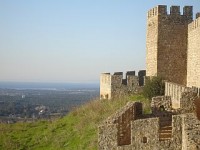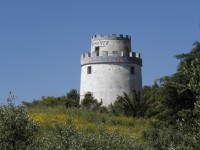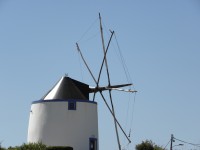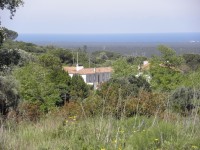During your holiday at Monte Horizonte you will stay near the historic town of Santiago do Cacem. Here some information about this lovely town and its surroundings.
THE CITY SANTIAGO DO CACEM:
The origins of the castle of Santiago do Cacem are rather curious, the result of the victory of a warrior princess over a fierce Moor called Kassen that took place on Santiago's (St James's) day.
She therefore named it Santiago de Kassen, which, over the time, became Santiago do Cacem. Rectangular in shape, ten towers and cubic turrets reinforce the walls.
There is a superb view from the castle, whichever way you look.
HISTORY:
Excavations at Castelo Velho (Old Castle) on a hill to the east of the present city, date human occupation of the region to pre-historic times. The settlement, dating from the late Neolithic, was fortified by the Celts (3rd and 2nd centuries BC) and subsequently Romanised. Under Roman occupation, Mirobriga grew up as an agricultural and livestock centre, complete with its spas, and its importance can be seen, for example, in its large hippodrome used for training and horse racing.
Following the Germanic invasions of the 5th century the region lost importance, and the Moors built a new castle on a hill opposite that they called Cacem, probably in honour of an alcalde or sheriff.
SANTIAGO DO CACEM:
This land is a blend of maritime roast, pine forest and Alentejan inspiration. It is the country's second biggest municipality and its highest elevation is to be found in the Cercal hills at a height of 346 metres.
From here one can see the vastness of the sea to the West Those travelling in this region who are interested in handicrafts can find chairs and stools made of wood and wicker at sao Bartolomeu da Serra and at Sao Domingos da Serra, saddlery at Santiago do Cacem and at Cercal do Alentejo, ceramics at Santo Andre and Ennidas Sado and woodwork and cork at Cercal do Alentejo.
SANTO ANDRE LAGOON AND BEACHES:
Close by the sea lies the Santo Andre Lagoon, an excellent place for windsurfers. In addition to its wealth of fish, a large variety of water birds is also to be found, including duck, godwit, heron and grebe.
Those with a love of beautiful places just to "sit and think", can rest at will in this peaceful spot and enjoy the fish or eel stews which, of themselves, are a promise of marvellous gastronomic holidays.
Then there is the invitation to the beaches, with their fine white sands, to stroll along several kilometres between the blue and the tranquillity.
ABELA:
A small village of typically Alentejan architecture, its parish church standing imposing on top of a hill.
CAMPILHAS DAM:
A restful stretch of calm water providing excellent conditions for canoeing, windsurfing and angling.
SAO FRANCISCO DA SERRA:
A typical Alentejan village marked by its magnificent chimneys. The church and the ruins of Nossa Senhora do Livramento warrant a visit.
ALVALADE:
A village with an enchanting landscape located between Campilhas Stream and the river Sado.
CERCAL DO ALENTEJO:
A town surrounded by interesting farms and estates. About four kilometres away there is a spot providing excellent views over the Atlantic Ocean and the Serra da Mina.
Vacation in Portugal, holiday in the Alentejo.













